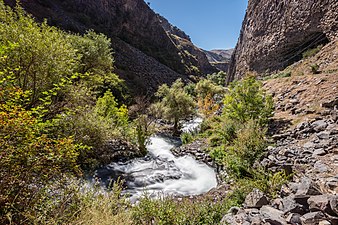
The Garni Gorge is situated 23.3 kilometres (14.5 mi) east of Yerevan, Armenia, just below the village of the same name. The Garni Gorge is protected by law and listed as a natural monument. On a promontory above the gorge the first-century AD Temple of Garni may be seen. Before Armenia converted to Christianity in 301 AD, Greek gods were worshipped at this temple. Along the sides of the gorge are cliff walls of well-preserved basalt columns, carved out by the Goght River. This portion of the Garni Gorge is typically referred to as the "Symphony of the Stones." It is most easily reached via a road that leads left down the gorge just before reaching the temple of Garni. Another road leads to the gorge through the village, down a cobblestone road, and into the valley. Once in the valley, turning right will lead to Garni Gorge, an 11th-century medieval bridge, and the "Symphony of the Stones". Taking a left will lead along the river past a fish hatchery, up to the Khosrov Forest State Reserve, and a little further Havuts Tar Monastery.
The ancient Geghard Monastery, a UNESCO World Heritage Site, is also within walking distance. Partially carved into the mountain, the monastery has existed since the fourth century AD. The main cathedral was built much later, in the thirteenth century.
Gallery
-

-
 Example of basalt columns ("Symphony of the Stones") along Garni gorge
Example of basalt columns ("Symphony of the Stones") along Garni gorge
-
 Garni valley
Garni valley
-
 Garni stream
Garni stream
-
 Symphony of stones
Symphony of stones
-
 Panoramic view of Garni Gorge and the "Symphony of the Stones" basalt rock formations
Panoramic view of Garni Gorge and the "Symphony of the Stones" basalt rock formations
References
- "Garni Gorge". atlasobscur. Retrieved 2024-02-24.
- "Garni Gorge". atlasobscur. Retrieved 2024-02-24.
- "Garni Gorge". atlasobscur. Retrieved 2024-02-24.
- Kiesling, Brady (2005), Rediscovering Armenia: Guide, Yerevan, Armenia: Matit Graphic Design Studio
External links
40°07′10″N 44°43′23″E / 40.11944°N 44.72306°E / 40.11944; 44.72306
This Armenia location article is a stub. You can help Misplaced Pages by expanding it. |